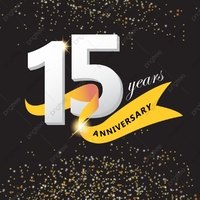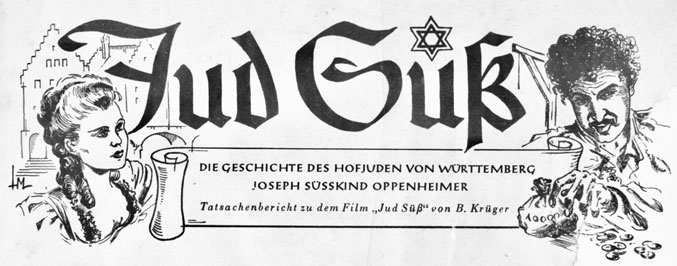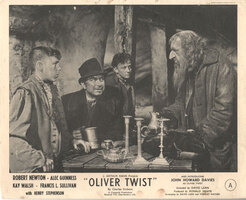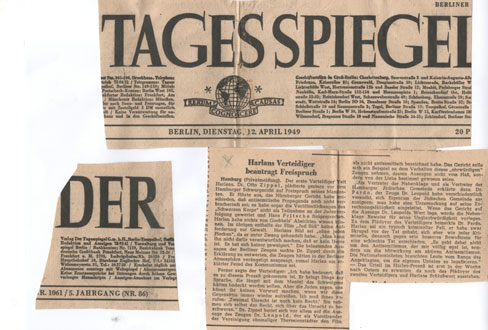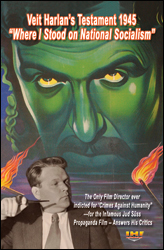The Jud Süß "Crimes against Humanity" 1949
trial of Director Veit Harlan – Special Section
Well before the end of the European War - in 1943 * – German film directors were being considered by the Allies and Soviet Union to be prosecuted for "crimes against humanity" and/or "war crimes" for making propaganda motion pictures for the Third Reich. As the charge of "war crimes" was invented ex post facto as a method to prosecute and execute Nazi leaders at Nürnberg, it also led to the first–ever charges against a film director since the invention of the art form. Harlan was duly charged and he had to endure two trials -- after he was found not guilty at the first one in 1949, the powers-that-be attempted to convict him a second time, but once again failed.
(*) The Moscow Declaration of October 30, 1943, “Concerning Responsibility of Hitlerites for Committed Atrocities” and the London Agreement of August 8, 1945, “Concerning Prosecution and Punishment of Major War Criminals of European Axis” established the basis for the Allies to prosecute war criminals. The Allies subsequently enacted a law to codify what constituted war crimes and what their punishments should be.
The first trial was put into play by the Public Prosecutor of Hamburg on behalf of the "Union of the Persecuted by the Nazi-Regime" (VNN) and the "Emergency Community of those affected by the Nuremberg [Racial] Laws," citing the Allied Control Law Nr. 10 of 20 December 1945, establishing 'Crimes Against Humanity' charges on behalf of those minorities persecuted on political, racial or religious grounds.
The Prosecutor, Dr. Gerhard Kramer, cynically told Harlan before the trial began why he was being charged personally for directing Jud Süß, rather than holding the film studio Ufa Harlan worked for as being responsible for the film's production and distribution:
"If you want to sue for a million, it's a very expensive and risky thing. The wise man will sue for a partial amount - about 10,000 marks. It's not that expensive. If he wins the 10,000 marks, then the rest falls to him without risk. It is similar with you. You are the 10,000 marks. If you are convicted, Goebbels’s entire German film industry will have its turn. Then we have a 'model judgment.' " (Harlan, Veit; Im Schatten meiner Filme autobiography, Pg.216).
From these remarks it is obvious that the prosecution was uncertain it could win a case against a powerful film studio with deep pockets to defend itself, and therefore charged Harlan, an individual whose assets at the end of the war were so few that he was in effect already bankrupt. The Harlan house had been destroyed by the Allied terror bombing of Berlin, and they were now living in a rental apartment in Hamburg -- or what was left of it -- after the Allies killed at least 37,000 civilians and wounded a further 180,000 through napalm carpet bombing. He still had a work ban placed on him by the Allies, and the family's only rather meagre income was being earned by his wife Kristina Söderbaum when she could find work in a touring theatre company from time to time. He directed her plays in secret, and was not listed on the billing. She also sold her jewelry off during these hard years.
Because the individual who was most responsible for the production of the film, Dre. Joseph Goebbels, was deceased and the prosecution put the film's director rather than the production studio Ufa, on trial, key former Third Reich film decision–makers such as Fritz Hippler (Reichsfilmintendant) and Terra Filmkunst Head of Productions Alf Teichs were called to testify as witnesses for the prosecution. The absurdity of having Dr. Goebbel's right–hand man in Hippler appearing against Harlan –- the man who had done the Propaganda Minister's bidding to get Harlan to be the Director, was bizarre if not absurd. Ditto, Teichs, who issued Harlan's contract as the film's Director.
The prosecution tried to paint Harlan as an anti-Semite driven to make the film for ideological reasons; basing their argument partly on an interview Harlan gave in 1933 to the Völkischer Beobachter to a reporter who was herself part-Jewish. Harlan argued that pro-National Socialist comments attributed to him in the article were concocted by the paper afterwards because he was not as enthusiastic as they would have wished. Witnesses who appeared on Harlan's behalf pointed out that he had saved Jews and "half Jews" and/or their spouses during the war, and Harlan himself testified that he had grown up in a household with many Jewish friends of his father and mother in attendance; and that his three theatre mentors were all Jews ––namely Reinhardt, Jeßner, and Herzfeld. Further, Harlan's first wife has been a Jewess. Finally it was a fact that he had never joined the NSDAP.
The prosecution tried to implicate Harlan as one of the film script's authors. The first two scripts had been written by authors Moeller and Metzger respectively; and a third final script was then devised which included input from Harlan. The prosecution failed to present a proper comparison of the scripts to argue their case as to Harlan's involvement because they did not in fact have the first Moeller script to compare. Harlan testified that he in fact toned down the final version and tried to make it less anti–Jewish, in which the final words of Süß Oppenheimer on the gallows curses the court and trial and on-lookers; using words out of the actual historical trial proceedings. It was proven in Harlan's trial that Dr. Goebbels strongly objected to this curse and personally re–wrote the words Süß makes in the film. This required an expensive re–shoot of the final scenes and dubbing of Süß's voice by Ferdinand Marian.
The first Harlan trial lasted for 51 stressful days and towards the end, Veit Harlan suffered his third heart attack, but managed to speak to the court for two hours in his own defence as the hearings drew to their conclusion.
The Prosecutor, Dr. Kramer demanded in his summary that Harlan be found guilty and that he be imprisoned for two years and fined the then enormous sum of 105,000 Marks.
The "model judgment" Dr Kramer mentioned was meant to be the benchmark successful prosecution against Harlan which would have then led to other German and Austrian film directors such as Karl Ritter, Wolfgang Liebeneiner, Gustav Ucicky and others to be similarly charged and put on trial for film–making.
As one journalist covering the trial put it, Harlan "had the high honor of being the victim for all of the Nazi film directors." (as quoted in the Kristina Söderbaum memoirs).
In the judgement handed down which found Veit Harlan not guilty, one of the pivotal determinations was that "it appears unfounded that the various acts of persecution of the Jews was an immediate consequence of the distribution of the Jud Süß film," and that the Nürnberg Trials had established that it was "at the earliest the Summer of 1941 when the plan for the Final Solution [of the Jewish Problem] was made;" whereas the film was cast in late 1939 and produced in 1940. The judges also found that Harlan's defence that his life would have been threatened by his refusing the direct the film was unproven; as other directors and actors had turned down involvement and Harlan was therefore seen as someone who wished to ingratiate himself with the Regime and further his career. It however found that his revised film script did not reflect the wishes of Dr. Goebbels and that the film was changed and the final hanging scene re-shot to Goebbels' own satisfaction of which Harlan had no involvement.
When Harlan was acquitted at his first trial, the judge stated amongst other things that the "psychological oppression of the Jews came not from the film but were caused by the movie advertising." By that he meant the sensational posters with the green skinned Süß as a demon.
Our Karl Ritter archives hold the Soviet Communist Party newspaper of 8 Septmber 1945 (Deutsche Volkszeitung, Berlin) demanding that the Americans try Ritter for war crimes, as the director was in a US prison at the time. Similarly, an American OSS secret report issued that same month cited the anti–Polish film Heimkehr and recommended that its Director (Gustav Ucicky) and its script-writer, Gerhard Menzel, both be charged with war crimes. The Americans thus showing that they were just as vicious and vengeful as the Soviets. Luckily only Veit Harlan was ever charged with such "crimes" and after his two trials ended in failure, no other German film directors and senior film producers were tried, except those held in Soviet gulags such as H.H. Zerlett, Gustav Rathje -Producer of Ritter's GPU, who both died in custody. The best-selling author and film producer and director Hans Zöberlein (his two films: Stoßtrupp 1917, Um das Menchenrecht) was arrested and imprisoned for murdering anti-Nazi partisans and members of the public in April 1945 as part of a "Werewolf" operation at war's end, but his two Nazi propaganda films were not one of the charges against him, and were completely coincidental.

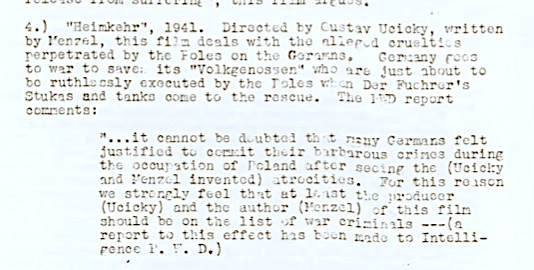
There are 3 original German Press Agency press photos in our Collection which cover his 1949 Hamburg trial. One is of him in the courtroom on the first day of the trial; another is that showing him riding on the shoulders of well-wishers outside the courtroom after he was found "Not Guilty. " Both of these photos are been reproduced fairly frequently in Harlan books and articles. The third photo we have is the one shown below, which is less often published. It shows Harlan amongst the audience in the Hamburg Esplanade cinema on the third day of his trial. The court ordered the screening of both Harlan's Jud Süß film as well as Hippler's Der ewige Jude, to compare and contrast the two anti–Semitic films. The prosecution argued that Harlan's film was evil and a direct signpost and contributor to 'crimes against Humanity' just as Hippler's film was. (We can only conclude that the Harlan film would have been seen as far less virulent and anti-semitic than the Hippler film; and that this screening of both films could well have played a role in Harlan's acquittal six weeks later.) Harlan's chief defence counsel, Dr. Otto Zippel, is to the left of Harlan in the photo below, taking his seat with a smile, and Harlan's loyal and hard–working Secretary, Lu Schage, is the woman following behind Harlan at the right, pushing her way through the row of spectators.
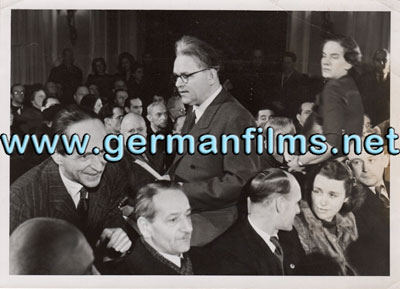
In addition to the screening of Hippler's Der ewige Jude and Harlan's Jud Süß, two other Harlan films were presented to the court as part of the first trial. They were the two Agfacolor films Immensee and Kolberg (as per the Hamburg Echo newspapers dated 8 and 19 March 1949 respectively in our Harlan Collection.)
During the discussion in the trial proceedings, the new film Oliver Twist by David Lean was raised in terms of the charge of anti–Semitism in Fagin's characterisation by British Jewry and protests against the cinemas screening the movie.
In addition, we have 36 original complete newspaper clippings from Germany published in 1949 covering the trial in Hamburg in which Veit Harlan was accused of a "crime against humanity" for helping script and then directing the notorious film Jud Süß in 1940. The film was seen by over twenty million Germans as well as millions of foreigners in both Occupied and neutral countries in 1940/1941, and it was reprised again before war's end.
The articles' headers are shown below along with a few few–sized article clippings.
The Collection holds eight original Jud Süß film posters and one Italian "Fotobusta," as well as other film ephemera about the film. Although we do not have an original German poster as designed by Rehak in our Collection, we have a 'sister' poster from Belgium which follows the Rehak closely, as well as two French posters, two Italian posters, an Italian colour "Fotobusta", a Böhmen & Mähren poster with both German and Czech text, and the super–rare re–release poster from 1941 Hungary. We also have 37 B&W original film stills for the film, 2 full–colour rare light box film sheets (A4 sized) for cinema lobby display, and the French original press book for the film. In 2017 we won at auction in Munich the personal annotated copy of the first edition of the film script owned by great actor Werner Krauss. His hand–written annotations are of additional dialogue added during the production of the film for one of his characters, Councilor Levy. The final version of the film script contains these lines of dialogue. Most of these items can be found elsewhere on this website, under FILM STILLS, POSTER GALLERY, etc.
BELOW: a newsstand kiosk poster for the Köln Illustrierte covering the death of actor Ferdinand Marian, the actor who played the title role of Süss in the film. Marian died in a car accident on an open road when the  auto hit a tree. The weather was fine, he may well have been drinking, but the rumour spread that he committed suicide, although at the first Harlan trial his wife (shown in a newspaper photo of her testifying at the trial at left) did not say anything which would support this. She read to the Court a certified statement about the film which her husband had signed in September 1945, which supported Harlan's case. She died months later herself in a mysterious drowning which has never been explained, and there are rumours that she was actually murdered after her testimony supporting Harlan as a witness for the defendant. The kiosk poster from our Collection.
auto hit a tree. The weather was fine, he may well have been drinking, but the rumour spread that he committed suicide, although at the first Harlan trial his wife (shown in a newspaper photo of her testifying at the trial at left) did not say anything which would support this. She read to the Court a certified statement about the film which her husband had signed in September 1945, which supported Harlan's case. She died months later herself in a mysterious drowning which has never been explained, and there are rumours that she was actually murdered after her testimony supporting Harlan as a witness for the defendant. The kiosk poster from our Collection.
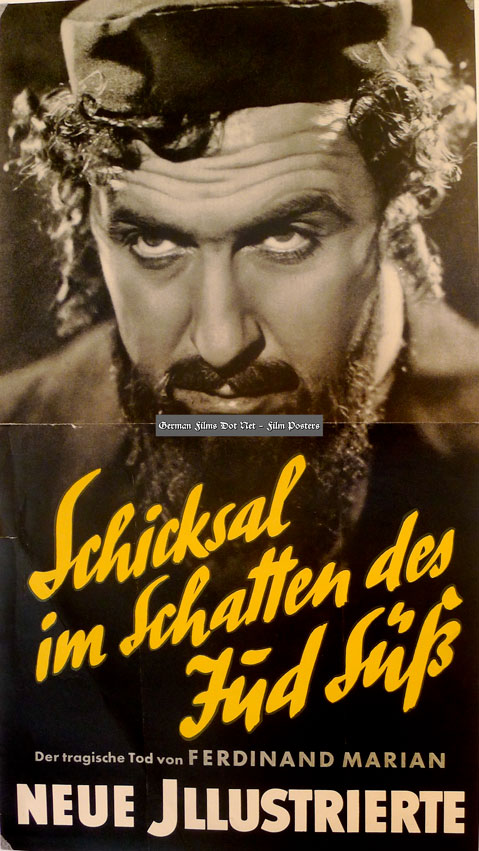
We also own one of the only surviving original 21 page typed statements Harlan wrote in the dying days of the war, entitled "Where I stood on National Socialism." The document explains, in his own words, the background to and filming of Jud Süß as well as the other propaganda films Harlan directed. Our original is signed by Harlan on the final page and dated by him on the first page. It has been translated and is for sale from International Historic Films in Chicago, IL. USA here.

